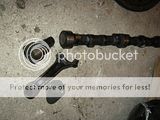With a 9.38" deck register, 1.21" pistons and 6.24" rods I use, the pistons stick out +50 thou. A minus(-)16 thou is the ideal quench for Boss302, Boss 351, 351 4V HO Clevelands and stock X-flows. Ideal gasket for each is multi layer composite of about 41 thou. These engines are the worst detonators when the spark, piston ahd heads are poorly matched, but are awesome when matched.
The 4.6 3.700" forged piston is great, they run cooler and you can use factory UA Ford Corsair 2389 cc con rods like I use on my planned FAZER 6Bi (Blowen & Injected) or FAZER 6Ti (Turbo & Injected) engines.
These are ex Nissan 2.4 litre KA24E inline-four conrods. This engine was found in the Australian Nissan Pintara/Ford Corsair pair produced from 1989 to 1992, but found in many other Nissans worldwide up to 2004 (incl Xtrail). It power was a very ordinary nominal 129 hp at 5,600 rpm and 139 ft·lbf at 2,800 rpm, but is the basic 240SX engine, and I wouldn't suggest it unless it was ballistically strong. And they are! They are 300 Ford spec for strength, but have a nice small big end and little end to suit the Ford Modular piston. You have to regrind the crank bearings to suit, but there's nothing in that compared to the cost of, say Astron 80 2.6 6.5" conrods or any number of aftermarket versions.
Long ago over here, I removed an AIT Turbo equiped 4.1 headgasket and crank from a blown Fairlane back in 2003 when doing my AOD adaptor trial fit. I showed the rods from that failed combo briefly. The process to get the right quench would be to have an alloy, tin or steel 22 thou thick adaptor made up on a CNC lathe, and use two Permaset 41 thou gaskets. That way you get the right quench. You must ensure the cooling system and those back water holes in the block don't ever rust the intermediate steel/tin/alloy/copper gasket, or it will be trash like that Turbo engine was. Here is its gaskets on my old 1982 X-flow block.




When turboed, here is what can happen to a stock X-flow conrod under load more than 360 hp and 14 pounds of boost. This became an early hot rod Twin cam engine (pun intended).

22 thou plus one extra 41 thou Permaset give you 13 thou quench with a 50 thou above 4.6 piston and KA24E rods. These decompression plates were used on most aftermarket turbo (Mike Vine, AIT, TurboTechnics, Normalaire Garret, Ray Hall) Falcon kits from 1980 to 1987, mainly because Ford varied its combustion chambers lots over the XD, XE and XF run to meet three national and two NSW State emissions standard changes.
Gasoline and those later alloy high swirl heads and an agressive stock TFI spark system can kill your bottom end. Or, if you use a 291 degree cam, EDIS, and good ecu, forged pistons and premum rod bolts with good stock rods to avoid incipinet knock (Georges 10 second TD Cortina has them), it will last a long, long time, even under 25 pounds of boost.






